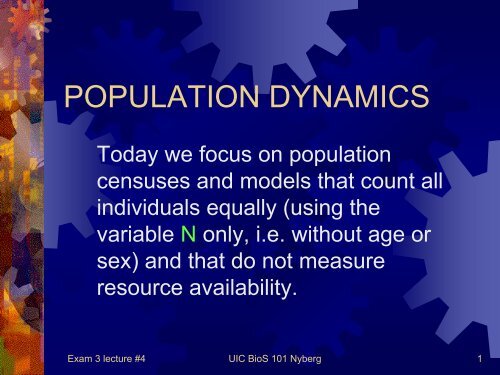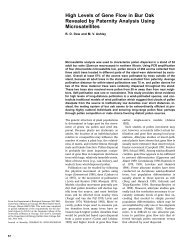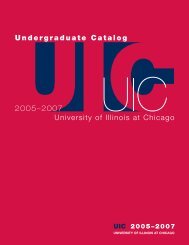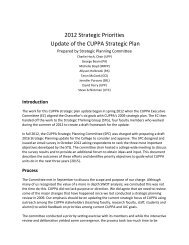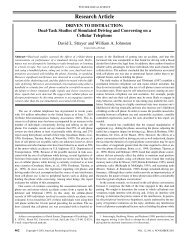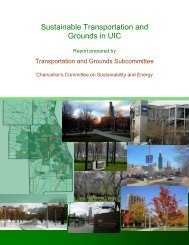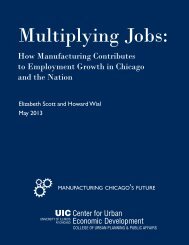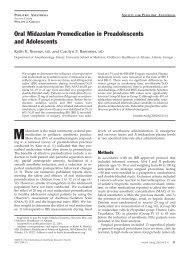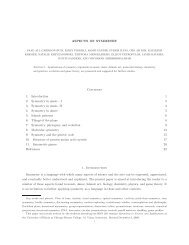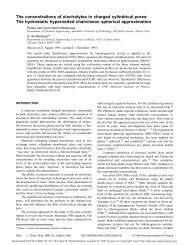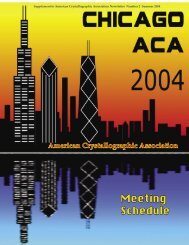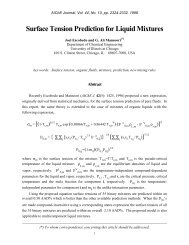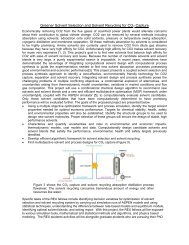POPULATION DYNAMICS
POPULATION DYNAMICS
POPULATION DYNAMICS
Create successful ePaper yourself
Turn your PDF publications into a flip-book with our unique Google optimized e-Paper software.
<strong>POPULATION</strong> <strong>DYNAMICS</strong><br />
Today we focus on population<br />
censuses and models that count all<br />
individuals equally (using the<br />
variable N<br />
only, i.e. without age or<br />
sex) and that do not measure<br />
resource availability.<br />
Exam 3 lecture #4 UIC BioS 101 Nyberg 1
Reading<br />
Chapter 52.2.<br />
Box 52.2 (p1043-44) -read carefully<br />
Box 52.3 (p1048) on Mark-Recapture<br />
Review of the x1 07 lecture may be<br />
useful to understand population growth.<br />
Chapter 52.1 introduces demographic<br />
models using age of individuals.<br />
Exam 3 #4 UIC BioS 101 Nyberg 2
Changes in population size<br />
In a sustainable world, we expect population<br />
sizes of animals and plant species to stay<br />
about the same, N constant thru time.<br />
Reproduction gives organisms the potential to<br />
grow exponentially.<br />
Population growth eventually exhausts the<br />
resources and maintenance of population is<br />
dependent on renewal of resources.<br />
Exam 3 #4 UIC BioS 101 Nyberg 3
Determining population size<br />
Census = Count all the individuals<br />
Generally tough to do<br />
Sampling<br />
Create subpopulations (often based on<br />
area), count individuals in subpopulations,<br />
extrapolate to entire population/area<br />
Mark-Recapture Studies<br />
Sample, mark, release, resample<br />
Exam 3 #4 UIC BioS 101 Nyberg 4
Mark-recapture basics<br />
Box 52.3 (p1048)<br />
Perhaps simplest to understand in small lake<br />
Capture individuals, mark (tag) them, release n 1<br />
marked individuals, now n 1 / N is fraction marked.<br />
Assume the marked animals disperse and<br />
mix with unmarked animals in lake<br />
Capture n 2 individuals, if m 2 is # marked, the fraction<br />
marked is m 2 / n 2 & should be equal to n 1 / N .<br />
then N = total # in population = n 1 •n 2 / m 2<br />
Exam 3 #5 UIC BioS 101 Nyberg 5
Mark-recapture example<br />
You catch 14 butterflies and mark the<br />
thorax with white paint and then release<br />
the butterflies.<br />
Two days later you go out and net 18<br />
butterflies and find 4 of them marked.<br />
The Estimate of the total population =<br />
14 x 18/4 = 63 butterflies.<br />
Exam 3 #5 UIC BioS 101 Nyberg 6
Census Histories<br />
The Census history is the record of the<br />
numbers of individuals through time<br />
Some populations show a pattern of<br />
constant doubling for a period of time.<br />
Many populations are stable in size.<br />
Some species have a pattern of steady<br />
decrease.<br />
Many insects have population “outbreaks”<br />
with large fluctuations from year to year<br />
Exam 3 #5 UIC BioS 101 Nyberg 7
Census history examples<br />
Exam 3 #5 UIC BioS 101 Nyberg 8
Minimum Doubling Time<br />
The time it takes for a species to double<br />
the number of individuals even when<br />
resources are abundant is called the<br />
doubling time.<br />
Both geometric and exponential growth<br />
imply a constant doubling time, doubling<br />
time simply related to r, growth rate, is a<br />
parameter of the species.<br />
Exam 3 #5 UIC BioS 101 Nyberg 9
Population Size<br />
at a particular time<br />
N is the symbol for the variable population<br />
size<br />
N t = means the population size at time t, as a<br />
subscript it implies the geometric or discrete<br />
time model.<br />
N t + 1 = population size one generation after t<br />
The exponential or continuous time model<br />
would be written as N(t), verbally ‘N as a<br />
function of time’.<br />
Exam 3 #5 UIC BioS 101 Nyberg 10
Population Change<br />
using birth & deaths and migration<br />
Plus Births, B is number of births<br />
Minus Deaths, D is number that died<br />
Plus Immigrants, I = # that moved in<br />
Minus Emigrants, E = # that left<br />
N t+1<br />
= N t + B – D + I - E<br />
If population is closed, N t+1 = N t + B – D<br />
ΔN = N t+1 -N t = B – D = change in size<br />
Exam 3 #5 UIC BioS 101 Nyberg 11
The Whooping Crane<br />
The species is ENDANGERED<br />
according to US law.<br />
The population was once at least<br />
10,000 birds (always rare).<br />
The population was reduced to only 20<br />
birds in the 1940s.<br />
The population has been growing<br />
exponentially for about 60 years.<br />
Exam 3 #5 UIC BioS 101 Nyberg 12
Census history of Whooping Crane<br />
Exam 3 #5 UIC BioS 101 Nyberg 13
Geometric Growth Model<br />
N t+1 = λ• N t<br />
λ, lambda,is the multiplier from<br />
one generation to the next.<br />
= 1, the population size<br />
stays the same = is constant.<br />
If λ<br />
Exam 3 #5 UIC BioS 101 Nyberg 14
Exponential Growth Model<br />
N(t) = N 0 •e r•t<br />
The parameter that measures growth is r,<br />
which measure the instantaneous per capita<br />
growth rate per unit time.<br />
If r = 0.04 yr -1 the population grows 4% per<br />
year, as e 0.04 = 1.04 approximately.<br />
If r = 0, the population size does not change<br />
Exam 3 #5 UIC BioS 101 Nyberg 15
Exponential Growth Model<br />
Can also be written in “differential” form:<br />
dN/dt = r•N where dN/dt is the change<br />
in abundance per unit time change and<br />
r is the per capita growth rate.<br />
Note that if r =0 the population is not<br />
changing in size, i.e. dN/dt =0, and if r is<br />
negative the population is decreasing.<br />
Exam 3 #5 UIC BioS 101 Nyberg 16
Relationships of λ<br />
and r<br />
λ = e rt or e r if time is one unit long.<br />
If λ < 1, then r will be negative, i.e. the<br />
population is declining (exponential decay).<br />
If λ > 1, then r will be greater than zero and<br />
the population will increase geometrically.<br />
Exam 3 #5 UIC BioS 101 Nyberg 17
Modifications of growth model<br />
Populations don’t grow indefinitely, but<br />
rather reach a maximum density.<br />
The logistic model is a simple<br />
modification of exponential growth that<br />
leads to curve (sometimes referred to a<br />
‘s’ shaped) that conforms to<br />
observations of batch cultures.<br />
Exam 3 #5 UIC BioS 101 Nyberg 18
The “logistic”<br />
model of growth<br />
We take our exponential model (per<br />
capita growth constant) and add a new<br />
parameter, a, that reduces the growth<br />
rate in proportion to the population size<br />
dN/dt = r•N – a•N2 per capita growth rate dN/N•dt = r – a•N<br />
dN/<br />
N•dt<br />
N<br />
Exam 3 #5 UIC BioS 101 Nyberg 19
Paramecium<br />
Exam 3 #5 UIC BioS 101 Nyberg 20
N<br />
The Logistic Equation<br />
Time<br />
See Fig. 52.7a<br />
Exam 3 #5 UIC BioS 101 Nyberg 21
Metapopulations<br />
Species are usually made up of patches<br />
of populations with few individuals found<br />
in the area between the patches.<br />
The population is said to have a<br />
metapopulation structure if population<br />
extinction and colonization of empty<br />
suitable patches is frequent.<br />
Exam 3 #5 UIC BioS 101 Nyberg 22
Meta-<br />
popula<br />
tions<br />
Exam 3 #5 UIC BioS 101 Nyberg 23
Population Abundance Cycles<br />
Some populations show regular<br />
fluctuations of population size.<br />
Evenly repeated highs and lows are<br />
known as population cycles.<br />
The Lynx (a cat that eats hares) and<br />
hare (rabbit) populations cycle with an<br />
11 year period. The Lynx hi and low<br />
trails the hi and low of the hare.<br />
Exam 3 #5 UIC BioS 101 Nyberg 24
Hare & Lynx populations<br />
Exam 3 #5 UIC BioS 101 Nyberg 25
Outbreaks<br />
It is not unusual for populations of<br />
insects to vary greatly from year to year<br />
Very great increases in abundance are<br />
called “outbreaks”<br />
Examples in 2003 include the Painted<br />
Lady butterfly & the Asian Ladybug<br />
Exam 3 #5 UIC BioS 101 Nyberg 26
Census History with Outbreak<br />
N<br />
Time<br />
Exam 3 #5 UIC BioS 101 Nyberg 27
Vocabulary<br />
Constant Doubling time<br />
Geometric growth<br />
Exponential growth<br />
metapopulations<br />
parameter<br />
Emigrants, immigrants<br />
Census history<br />
Outbreak<br />
N 0 •e r•t<br />
Logistic growth<br />
Cycle<br />
λ, lambda<br />
Exam 3 #5 UIC BioS 101 Nyberg 28


